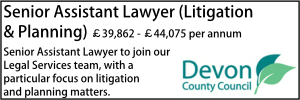HS2 detail approvals schemes
- Details
The High Court has rejected a council’s legal challenge to an HS2 detail approvals scheme. Matthew Dale-Harris explains why.
The High Court (Sir Duncan Ouseley) has handed down judgment in R(Buckinghamshire County Council) v Secretaries of State for Transport and for Levelling Up, Housing and Communities [2022] EWHC 1923, three consolidated judicial reviews challenging decisions by the Secretaries of State to grant appeals in relation to lorry routes to be used to access HS2’s worksite in the Midlands.
There were three common grounds of challenge relating to the separate planning decisions.
The first concerned the information which has to be provided to the local authority for the request for approval to be valid, and how a dispute about the necessity for the information sought affects appeal rights to the Secretaries of State. The Council claimed that (applying the decision of the Court of Appeal in R (London Borough of Hillingdon) v Secretaries of State for Transport and for Housing, Communities and Local Government [2020] EWCA Civ 1005, referred to as Hillingdon 1 in the judgment) the effect of their decision that the material provided was insufficient to allow them to assess the lorry routes was that no valid application had been made, with the result that time to determine the application had not started to run and so no valid appeal could be brought.
The second common ground of challenge raised questions as to the interpretation of paragraph 6 of Schedule 17 of the High Speed Rail (London-West Midlands) Act 2017, and what scope it gives to the local authority to seek to modify the routes proposed by conditions.
The third and fourth raised approval specific issues including a failure to take account of cumulative impacts from some of the lorry routes.
Sir Duncan Ouseley rejected all of the grounds of claim.
Under ground 1 (which was the ground of most general interest), he disagreed with the Claimants’ interpretation of the ratio of the decision in Hillingdon 1 and of the statutory scheme. Having regard to the approach which was taken to disputes about validity under the general planning regime, he commented that
“109 The structure of the general planning legislation also suggests that if time is not to run, so that there can be no appeal from the local authority decision that a request has yet to be validly made, and that what is styled a request is not a request at all in the context of Schedule 17, a nonentity as Lindblom LJ described it, the material to be provided for validity has to be that without which no reasonable authority could reach a lawful decision, and without which either the local authority or the Secretaries of State, if an appeal were before them, would be bound in law to hold that no decision could be made. It is difficult to see that a process of determining validity by evaluation of reasonableness, relevance and proportionality, availability of other sources or even some analysis which could be undertaken by the local planning authority itself, can be a necessary statutory implication.”
He then considered the features of the Schedule 17 regime (which he noted were very general) and the cases on the TCPA regime (specifically Geall, Banes, Maximus Networks, Parker and Newcastle Upon Tyne). He then drew his main conclusions as follows:
“122 The short conclusion which I draw from this analysis is that, unless the statutory appeal provisions expressly exclude an appeal on validity, an appeal on validity can be entertained by the Secretaries of State. There is no such express exclusionary provision in the 2017 Act. The general purposive approach to the interpretation of appeal rights in planning legislation is that an appeal is available on issues relating to validity, including evaluative and factual matters, as part of the generally expressed appeal rights. Even where, in the general planning legislation, there is an express provision which prevents an authority having jurisdiction, the balance of authority favours the conclusion that there is a discretionary jurisdiction to hear the appeal. Parker is a good illustration of the good sense of such an approach. There is nothing in the context or structure of the 2017 Act to show that some such exclusionary provision in relation to appeals should be inferred, putting this Act at odds with the general approach in planning appeals, quite contrary to its specific purpose and structure. The more general approach is clearly intended by Parliament. Once there is jurisdiction to entertain the appeal, the merits fall for determination as well.
123. Mr Matthias saw the very difficulty for a Court, carrying out an assessment of the rationality of the local authority’s request by way of judicial review, as a reason why there would be fewer proceedings by way of judicial review than appeals if that route were available. He may be right that the sheer difficulty of persuading a court, at least without a lengthy examination of the points, that a request was irrational would deter the challenge. But to make the local authority’s view of the reasonableness of a technical request so difficult to challenge, does not fit with the role of the authority, nor with the particular statutory scheme, nor the general planning regime. It makes excessive detail, time- consuming and costly work to very little point, virtually unchallengeable, and puts the HS2 regime as an outlier on the opposite side of the range from where it is plainly intended to be. The appeals provide good examples of the problems which his submissions would create, if correct.
124. Accordingly, the Inspectors each had jurisdiction to hear the appeals. Each was entitled to consider the need for the information sought, and each was entitled to reach the conclusion they did, that the information supplied was sufficient, and then to reach a conclusion about that on its planning merits. In no case did the Council suggest that the Inspectors lacked sufficient material for a lawful decision; it accepted that reasonable Inspectors could reach those decisions. It was agreed therefore to be very different from the factual situation addressed by the Court of Appeal in Hillingdon 1. The Council had thus nailed its colours to the mast of validity. It did not suggest that the information it sought could have affected the choice of route; it could only therefore have gone to some unspecified sort of modification about the way in which the route was used. It did not suggest any conditions which should and could reasonably be imposed to deal with the situations which concerned it. Once its colours had been struck, the Council could not and did not suggest that the Inspectors should have considered the possibility of, let alone devised, conditions, which it had not suggested or drafted.”
He went on to dismiss the remaining grounds.
Matthew Dale-Harris is a barrister at Landmark Chambers. He acted for the Secretaries of State led by Richard Kimblin QC of No 5 Chambers.
Sponsored articles
Unlocking legal talent
Walker Morris supports Tower Hamlets Council in first known Remediation Contribution Order application issued by local authority
Principal Lawyer - Planning, Property & Contract
Legal Director - Government and Public Sector
Lawyer (Planning and Regulatory)
Contracts Lawyer
Senior Lawyer - Planning, Property & Contracts Team
Locums
Poll
20-01-2026 5:00 pm
12-02-2026 10:00 am












































